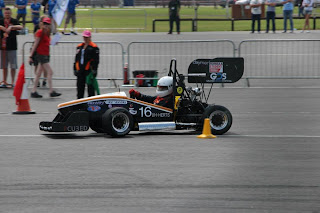There have been just a sprinkling of Australian drivers in
Formula One, but from that sprinkling of just fourteen, four World
Championships and thirty five wins have been achieved and celebrated with the
most successful being Jack Brabham.
Commanding the wheel of a Cooper, Brabham enjoyed back to back World
Championship success in 1959 and 1960.
At the end of the following year, Jack decided to leave Cooper and start
up his own team. Big changes loomed for
the 1966 season with engine size increasing to 3 litres, a change Brabham had
the foresight to prepare for, while other teams were not quite so
organised. He reaped the reward of his
canniness, bringing the car home to win four races that year to clinch his
third World Championship. To this day he
remains the only driver to have won a title in a car designed and manufactured
by the man in the cockpit.
 |
| Jack Brabham. Photo: www.news.drive.com.au |
Further Australian success was stalled until Alan Jones
commandeered his Williams to World Championship victory in 1980. With the FW07- Ford proving competitive in
1979, Jones took four wins, but despite taking more victories than Jody
Schekter and Gilles Villeneuve, seven retirements meant he came only third in
the Championship. With better
reliability the following year, Jones scored five victories in his FW 07B-
Ford, taking the title ahead of Nelson Piquet.
Rivalry between himself and team mate Carlos Reutemann hindered Jones’s
hopes of taking two consecutive championships as the Argentinean refused to
obey team orders to let Jones past at the 1981 Brazilian Grand Prix.
 |
| Alan Jones takes the title. Photo: www.bbc.co.uk |
Suffering similarly at the hands of a team mate for whom the
words ‘team orders’ don’t feature in his vocabulary is Mark Webber. The only other Australian driver to have won
a Formula One race, Webber has driven for Red Bull since 2007. Originally partner to David Coulthard, Mark
was joined by Red Bull Junior Sebastian Vettel in 2009, who graduated to the
senior team following the Scots retirement at the end of 2008. Narrowly missing out on the title to Vettel in
2010, Webber has since had to endure number two status at the team, causing a
fractious relationship between himself and Seb, that became unruly at this
year’s Malaysian Grand Prix, when he, just as his countryman Alan Jones had
twenty two years previously, watched his team mate ignore team orders to take
the chequered flag in his place. And
just as his countryman did twenty two years previously, Mark Webber will retire
at the end of the season.
 |
| Jones and Webber talk on the grid. Photo: www.zimbio.com |
The announcement of the retirement of the third Australian
to win a Grand prix paves the way for another to become the fourth. Aussie born Daniel Ricciardo, currently in
his second year at Toro Rosso, always knew this would be the year to prove
himself worthy of a seat at the senior team for 2014, and since the news broke
he has shone on track, especially in qualifying. His
performances were enough to earn him a half day outing in the Red Bull testing for
Pirelli at the Young Driver’s test at Silverstone.
 |
| Webber and Ricciardo. Photo: www.foxsports.com.au |
Daniel first tested for Red Bull Racing in December
2009. Achieving the fastest time of the
test overall, he subsequently became test and reserve driver for both Red Bull
and Toro Rosso in 2010. He was the only
driver to represent the team at the young drivers test at the Yas Marinas
circuit in Abu Dhabi where he put the previous week’s qualifying lap set by
Sebastian Vettel in the shade by recording the overall fastest lap of the
test. Confirmation of his status as Toro Rosso test
and reserve driver for 2011 together with FP1 appearances was his accolade. Completing
fifty nine laps at Silverstone last week, he was third fastest, and despite an
excursion into the gravel seemed positive about his efforts,
“It was my mistake really.
I lost the rear on the entry and was just probably pushing a little bit
too hard.”
His reputable test sessions have so far met with reward
regarding career progression; something he will be hoping continues in the form
of a seat at the senior team. Comments
made by Christian Horner to Sky Sports add fuel to his hope,
“It’s a perfect opportunity for us to slot Daniel in to the
car just to have a look at him as a part of our decision making process for Mark’s
replacement.” “This test fell fortuitously for us to put him in the car and
have a look.”
He is clearly enjoying proving himself ready for a seat with
Red Bull downplaying any possible pressure saying he is having fun. His endless positivity is endearing and he
will make a worthy replacement for Mark, both in terms of being his Red Bull
successor, and his countryman. If Red
Bull make the decision to give credibility to their young driver programme and
choose him over Kimi Raikkonen, he will have the opportunity to be the next
Australian to truly achieve success in Formula One. Daniel Ricciardo: Continuing to fly the flag
for Australia.













